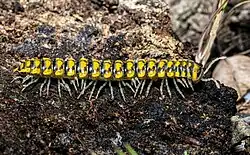Sigmocheir furcata
| Sigmocheir furcata | |
|---|---|

| |
| Scientific classification | |
| Kingdom: | Animalia |
| Phylum: | Arthropoda |
| Subphylum: | Myriapoda |
| Class: | Diplopoda |
| Order: | Polydesmida |
| Family: | Xystodesmidae |
| Genus: | Sigmocheir |
| Species: | S. furcata
|
| Binomial name | |
| Sigmocheir furcata Shelley, 1995
| |
Sigmocheir furcata is a species of millipede in the family Xystodesmidae.[1] The species in endemic to California and found in the foothills of the Sierra Nevada mountains.[1][2]
Description
Sigmocheir furcata was described by Rowland M. Shelley in 1995 based on samples collected by R. E. Graham from Williams cave in Calaveras County in 1963.[2] As with other members of the genus, S. furcata has a distinctive trimaculate pattern with an ovoid mid-tergite yellow spot and yellow paranota.[2] Compared to other members of the genus the paranota on S. furcata arise slightly lower on the tergites giving the millipedes a slightly more domed appearance.[2] The species has light colored/white legs and antennae, and the antennae are rather long, reaching back to the third tergite.[2]
Range
This species is the northern most representative of the genus being found in the foothills of the Sierra Nevada mountains to the north and south east of Sacramento.[2] Individuals of the genus have been found in Placer, El Dorado, Amador, Calaveras,and Sacramento, counties.[1][2]
References
- ^ a b c "Sigmocheir furcata". iNaturalist. Retrieved 2024-09-12.
- ^ a b c d e f g Shelley, Rowland M. (1995-01-01). "The Sigmocheirini, a xystodesmid milliped tribe in the Sierra Nevada Mountains, California, U.S.A. (Polydesmida: Xystodesmidae)". Insect Systematics & Evolution. 26 (3): 339–360. doi:10.1163/187631295X00044. ISSN 1876-312X.